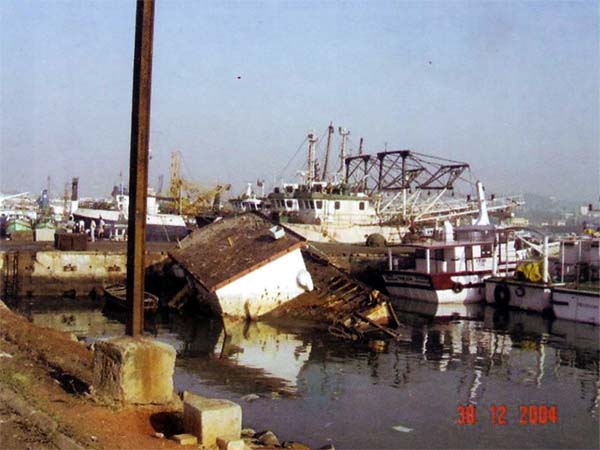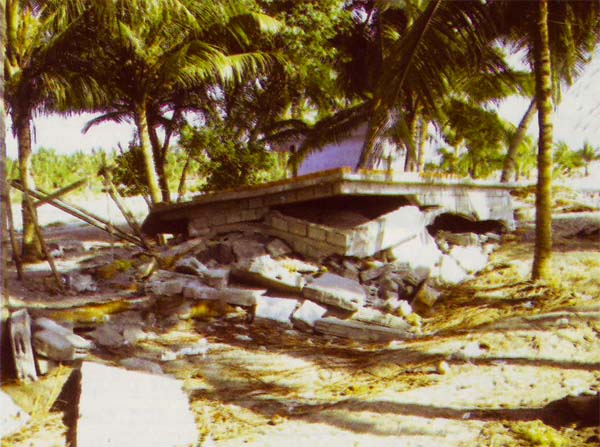Dec 13, 2025
Dec 13, 2025
We were taken unawares when the tsunami struck the east coast of India 26th December 2004. It was hard to imagine for the people that a tsunami could inflict so much of damage! Those who studied the earth science had read about the term, though it was never taught or studied seriously by the students in India, including the author. Since no tsunami had struck the Indian coast in the recent memory, no one took it seriously. In case the tsunami is generated by some other mechanism then? This is a question that is bugging the experts these days. The two recent reports are presented here to highlight the point. We all know that meteors hit our planet regularly. Sometimes when their size gets larger we call it a meteorite. But if the size of the meteorite becomes several kilometers in diameter we term it a bolide. Fortunately there is no record of a bolide hitting our earth since we came in to being. But some 65 million years ago one such bolide supposedly around 40km diameter hit the western continental shelf of India. A large crater around 40 km diameter was formed, termed as the 'Shiva Crater'.
The post tsunami scare has considerably changed the scenario. More and more geo-scientists are coming up with the findings of paleo-tsunami deposits or other evidences suggesting mega-tsunamis. The quantum of rocks/sediments moved and the distances sometimes they have traveled indicate the might of the past disasters when a tsunami acted as a mover and shaker.
The tsunami that hit the Andhra Pradesh, Tamilnadu and Kerala coasts was an aftermath of an earthquake of magnitude 9.3 that originated off the western Sumatra coast. The United States Geological Survey (USGS), ranked it as the fifth largest earthquake in the world in the past 40 years (Read 'When Death Danced on Sea Coast').
We already know that how deadly an earthquake generated tsunami could be! The last tsunami that hit the eastern coast of Indian peninsula took a toll of 16000 lives. In view of the loss of lives and properties further research on tsunami became imperative. Somewhat like an earthquake a tsunami can not be predicted, but yes if warning systems are in place at times it is possible to forewarn the far flung coastal populations to move to safer areas. But this is possible only when the tsunami is generated by an undersea earthquake or a consequential landslide.
N.C. Mehrotra a renowned paleobotanist, (presently Director Birbal Sahni Institute of Palaeobotany, Lucknow) along with his coauthors reported reworked spores and pollen of land plants from the drill cores recovered from the depths of ocean in Bombay offshore. The rocks (Panna Formation) that contained these pollens and spores were 65 to 33.7 million years old, while the flora recovered was much older (Carboniferous Era). The report (2001) raised curiosity, because during the Carboniferous Era (354 to 298 million years ago) when the micro-continents of Asia were still a part of Australia and Gondwanaland and as such the only Carboniferous pollen and spores that are known from the sub-continent are marine and from the Himalayas. The fossil spores and pollens recovered from the drill cores did not show any affinity with the marine flora.
The reworked fossils as such are of no use to the palaeontologists for the purpose of establishing the age or palaeogeography of the era in which they were deposited. But in conditions like the present one, they gained significance as there was no nearby source from where they could have landed there. Then from where they were transported and how? One explanation could be that these pollens and spores were present in the sediments which now lie buried under a huge pile of lava flows or Deccan Volcanic rocks, which constitutes a major part of the Indian Peninsula. The sediments with carboniferous flora were eroded, transported and deposited in the area now covered under the Arabian Sea off shore from Mumbai. But there is no evidence so far of the presence of Carboniferous sediments under the Deccan Volcanic rocks. Or they might have come from Carboniferous sediments of Africa-Arabia by waves, says Arun Kumar of Centre For Petroleum and Minerals Research Institute, King Fahad University of Petroleum and Minerals, Saudi Arabia, in his paper (Current Science, June 2008).
Well sea waves normally do not transport materials for such large distances. But yes in case of tsunamis the waves are known to move an assortment of materials over long distances. Of course generation of such a tsunami which could carry sediments over long distance also needs a viable explanation. Here the story takes an interesting turn.
This catastrophic event generated mega-tsunamis that raced around the globe and severally impacted the coastlines of western India, east African and southern Arabian Peninsula. Some of the tsunamis traveled northwest wards and impacted the Arabian continental shelf and moved on land till they hit the eastern and western margins of the Arabian shield.
Such gigantic waves can erode large tracts of existing rocks and that is exactly what they did. Carboniferous strata of Arabia containing terrestrial plant pollen and spore fossils were eroded and the flora was deposited with the sediments of Panna Formation in the Mumbai offshore basin.
Quoting two Japanese Tsunami experts K. Ida and Iwasaki, (1983) Arun Kumar says in his paper that tsunamis in the open ocean are not high, but on approaching the coast they gain height. With the decrease in the depth of water their wavelength and velocity also decreases, but the wave energy remains nearly constant. It is the level of wave energy that determines the degree of damage on the coast or the coral reefs and also the rate of erosion of sediments from the coast. Often the old marshes and peat get covered under a thin layer of tsunami sand. Thus coastal erosion, re-deposition, and deformation of coastal sediments are other important impacts of tsunamis.
The mega tsunami that caused deposition of terrestrial pollen and spores in Panna Formation occurred some 65 million years ago. That is during the transition from Cretaceous to Tertiary Era of the earth's history. One must understand the paleogeography of the Indian continent. Those days India was a floating Island in the Indian Ocean, located east of present day East Africa and approximately 1500 to 2000 km southeast of the Arabian Peninsula.
The Shiva bolide impact created giant tsunamis that traveled in circular waves in all directions. Amongst them the mega-tsunamis traveling northwestward hit the coast of the Arabian Peninsula and the gigantic waves moved further inland till they were reflected back by the rigid, high crystalline rocks of the southern and eastern margins of the Arabian Shield. Those reflected southeastwards came back to their place of origin, i.e. Mumbai offshore region. The mega tsunami waves as they hit the Arabian coast carried out intensive erosion and on their return journey brought the Carboniferous sediments and associated pollen and spore fossils and deposited them in the sediments of Panna Formation.
Well the transport of sediments with terrestrial pollen and spores took place millions of years ago. The evidences to prove that it was due to a tsunami are circumstantial. 'Nature' reported in October 2008 about another tsunami that hit the same region some 600 years ago. Teams of researchers found sheets of sands that were rushed inland and dropped by a tsunami in Thailand. Quoting Katrin Monecke a researcher from Pittsburg the report says similar sand sheets were deposited by 2004 tsunami as well.
These findings have lots of meaning for the planners of the coastal region. When a tsunami is the past can scour ad erode piles of sediments as far as Arabia and dump it in the Indian Ocean in Mumbai basin, who can stop another tsunami in future from repeating the feat! That is why as per the coastal zone regulations there are restrictions on constructing permanent or temporary dwellings close to the coast line. As per that no dwelling should come up within a distance of 500 meters. It is unfortunate that often these regulations are flouted. If a past event is repeated then the results would be disastrous.
25-Jan-2009
More by : V. K. Joshi (Bijji)